Predicting User Activity Intensity Using Geographic Interactions Based on Social Media Check-In Data
Abstract
:1. Introduction
- ●
- We represent the spatial relationship of user movement in the form of graphs, which can be directly input into the prediction model. Nodes represent regions, while edges represent adjacency. In addition, we used regional interactions extracted from historical activity data to construct the edges of the graphs. In this manner, the interactions of people in a physical space are considered.
- ●
- We used a deep learning model, which has been shown to perform well for predictions in discontinuous nonlinear problems. The model, which recasts the regression problem for predicting the spatial–temporal variation of users as a judgement model, uses a combination of the graph convolutional network (GCN) and gated recurrent unit (GRU). GCN, which is efficient at processing graph data, extracts spatial features [2,33,34]. These features are then input into the GRU, which extracts their temporal features. Finally, the GRU output is passed through a fully connected layer to obtain the predictions.
2. Methodology
2.1. Problem Description
2.2. GGCN-GRU Model
2.3. Construction of the Spatio-Temporal Graph
2.3.1. Spatio-Temporal Graph
2.3.2. Node Representation
2.3.3. Edge Representation
2.4. Spatial Feature Extraction by GCN
2.4.1. Spectral Domain Graph Convolution Operations
2.4.2. Layer-Wise GCN
2.5. Extraction of Temporal Features by GRUs
3. Experiments
3.1. Data Description
3.2. Data Processing
3.3. Assessment Metrics
3.4. Baselines
3.5. Model Parameter Settings
4. Results and Analyses
4.1. Comparing Accuracies of the Three Graph Construction Methods
4.2. Model Accuracies Using Different Time Granularities
4.3. Comparing GGCN-GRU to Other Common Spatio-Temporal Prediction Methods
4.4. Visualization
5. Conclusions
Author Contributions
Funding
Institutional Review Board Statement
Informed Consent Statement
Data Availability Statement
Acknowledgments
Conflicts of Interest
References
- Bao, Y.; Huang, Z.; Li, L. A BiLSTM-CNN model for predicting users’ next locations based on geotagged social media. Int. J. Geogr. Inf. Sci. 2021, 35, 639–660. [Google Scholar] [CrossRef]
- Yuan, N.J.; Zheng, Y.; Zhang, L. T-finder: A recommender system for finding passengers and vacant taxis. IEEE Trans. Knowl. DataEng. 2013, 25, 2390–2403. [Google Scholar] [CrossRef]
- Ma, X.; Tao, Z.; Wang, Y.; Yu, H.; Wang, Y. Long short-term memory neural network for traffic speed prediction using remote microwave sensor data. Transp. Res. Part C Emerg. Technol. 2015, 54, 187–197. [Google Scholar] [CrossRef]
- Wang, Y.; Zhou, X.; Noulas, A. Predicting the Spatio-Temporal Evolution of Chronic Diseases in Population with Human Mobility Data. In Proceedings of the 27th International Joint Conference on Artificial Intelligence, Stockholm, Sweden, 13 July 2018; pp. 3578–3584. [Google Scholar]
- Balcan, D.; Colizza, V.; Goncalves, B. Multiscale mobility networks and the large scale spreading of infectious diseases. In Proceedings of the APS March Meeting, Portland, OR, USA, 15–19 March 2010. [Google Scholar]
- Leskovec, J.; Horvitz, E. Planetary-scale views on a large instant-messaging network. In Proceedings of the 17th International Conference on World Wide Web, Beijing, China, 21–25 April 2008. [Google Scholar]
- Vaccari, A.; Liu, L.; Biderman, A. A holistic framework for the study of urban traces and the profiling of urban processes and dynamics. In Proceedings of the 2009 12th International IEEE Conference on Intelligent Transportation Systems, St. Louis, MO, USA, 4–7 October 2009; pp. 1–6. [Google Scholar]
- Gang, P.; Qi, G.; Wu, Z. Land-Use Classification Using Taxi GPS Traces. IEEE Trans. Intell. Transp.Syst. 2013, 14, 113–123. [Google Scholar]
- Yuan, N.J.; Zheng, Y.; Xie, X.; Wang, Y.; Zheng, K.; Xiong, H. Discovering Urban Functional Zones Using Latent Activity Trajectories. IEEE Trans. Knowl. Data Eng. 2015, 27, 712–725. [Google Scholar] [CrossRef]
- Feng, L.U.; Kang, L.; Jie, C. Research on Human Mobility in Big Data Era. J. Geo-Inf. Sci. 2014, 16, 665–672. [Google Scholar]
- Ding, M.; Toshihiro, O.; Takuya, O. Exploring the heterogeneity of human urban movements using geo-tagged tweets. Int. J. Geogr. Inf. Sci. 2020, 34, 2475–2496. [Google Scholar]
- Scellato, S.; Musolesi, M.; Mascolo, C. NextPlace: A Spatio-Temporal Prediction Framework for Pervasive Systems; Springer: Berlin/Heidelberg, Germany, 2011. [Google Scholar]
- Liao, D.; Liu, W.; Zhong, Y. Predicting Activity and Location with Multi-task Context Aware Recurrent Neural Network. In Proceedings of the Twenty-Seventh International Joint Conference on Artificial Intelligence, Stockholm, Sweden, 13 July 2018. [Google Scholar]
- Li, M.; Shi, X.; Li, X. Integration of spatialization and individualization: The future of epidemic modelling for communicable diseases. Ann. GIS 2020, 26, 219–226. [Google Scholar] [CrossRef]
- Bin, C.; Yi, M. Real-Time Estimation of Population Exposure to PM2.5 Using Mobile- and Station-Based Big Data. Int. J. Environ. Res. Public Health 2018, 15, 573. [Google Scholar]
- Cho, E.; Myers, S.A.; Leskovec, J. Friendship and mobility: User movement in location-based social networks. In Proceedings of the 17th ACM SIGKDD International Conference on Knowledge Discovery and Data Mining, San Diego, CA, USA, 21–24 August 2011. [Google Scholar]
- Li, X. Prediction of urban human mobility using large-scale taxi traces and its applications. Front. Comput. Sci. 2012, 6, 111–121. [Google Scholar]
- Liang, V.C. Mercury: Metro density prediction with recurrent neural network on streaming CDR data. In Proceedings of the 2016 IEEE 32nd International Conference on Data Engineering (ICDE), Helsinki, Finland, 16–20 May 2016. [Google Scholar]
- Hoang, M.X.; Zheng, Y.; Singh, A.K. FCCF: Forecasting citywide crowd flows based on big data. In Proceedings of the 24th ACM SIGSPATIAL International Conference on Advances in Geographic Information Systems, Burlingame, CA, USA, 31 October–3 November 2016. [Google Scholar]
- Andris, C. Integrating social network data into GISystems. Int. J. Geogr. Inf. Sci. 2016, 30, 2009–2031. [Google Scholar] [CrossRef] [Green Version]
- Shaw, S.L.; Yu, H. A GIS-based time-geographic approach of studying individual activities and interactions in a hybrid physical–virtual space. J. Transp. Geogr. 2009, 17, 2. [Google Scholar] [CrossRef]
- Crivellari, A.; Beinat, E. From motion activity to geo-embeddings: Generating and exploring vector representations of locations, traces and visitors through large-scale mobility data. ISPRS Int. J. Geo-Inf. 2019, 8, 134. [Google Scholar] [CrossRef] [Green Version]
- Li, J.; Liu, H.; Guo, W.; Chen, X. A spatio-temporal network for human activity prediction based on deep learning. Acta Geod. Cartogr. Sin. 2021, 50, 522–531. [Google Scholar]
- Chen, J. Fine-grained prediction of urban population using mobile phone location data. Int. J. Geogr. Inf. Sci. 2018, 32, 1770–1786. [Google Scholar] [CrossRef]
- Wang, S.; Yao, Z.; Yang, S. Discovering Urban Travel Demands Through Dynamic Zone Correlation in Location-Based Social Networks. In Joint European Conference on Machine Learning & Knowledge Discovery in Databases; Springer: Cham, Switzerland, 2018. [Google Scholar]
- Zhu, D. Understanding place characteristics in geographic contexts through graph convolutional neural networks. Ann. Am. Assoc. Geogr. 2020, 110, 408–420. [Google Scholar] [CrossRef]
- Castells, M. Rise of the Network Society: The Information Age: Economy, Society and Culture; Blackwell Publishers, Inc.: Cambridge, MA, USA, 1996. [Google Scholar]
- Xiu, C.L.; Wei, Y. City and Regional Structure from the View of “Space of Flows”; Science Press: Beijing, China, 2015. [Google Scholar]
- Pei, T.; Shu, H.; Guo, S.H. The concept and classification of spatial patterns of geographical flow. J. Geo-Inf. Sci. 2020, 22, 30–40. [Google Scholar]
- Zheng, Y. Trajectory data mining: An overview. ACM Trans. Intell. Syst. Technol. (TIST) 2015, 6, 29. [Google Scholar] [CrossRef]
- Deng, D.; Shahabi, C.; Demiryurek, U. Latent Space Model for Road Networks to Predict Time-Varying Traffic. In Proceedings of the 22nd ACM SIGKDD International Conference on Knowledge Discovery and Data Mining, San Francisco, CA, USA, 13–17 August 2016; pp. 1525–1534. [Google Scholar]
- Deveaud, R.; Albakour, M.D.; Macdonald, C. Experiments with a Venue-Centric Model for Personalised and Time-Aware Venue Suggestion. In Proceedings of the 24th ACM International on Conference on Information and Knowledge Management, Melbourne, Australia, 19–23 October 2015. [Google Scholar]
- Smola, A.J.; Schlkopf, B. A tutorial on support vector regression. Stats Comput. 2014, 14, 199–222. [Google Scholar] [CrossRef] [Green Version]
- Zhang, J.; Zheng, Y.; Qi, D. Deep Spatio-Temporal Residual Networks for Citywide Crowd Flows Prediction. In Proceedings of the Thirty-First AAAI Conference on Artificial Intelligence, San Francisco, CA, USA, 4–9 February 2016. [Google Scholar]
- Ren, Y. A hybrid integrated deep learning model for the prediction of citywide spatio-temporal flow volumes. Int. J. Geogr. Inf. Sci. 2020, 34, 4. [Google Scholar] [CrossRef]
- Yao, H.; Wu, F.; Ke, J. Deep multi-view spatial-temporal network for taxi demand prediction. In Proceedings of the Thirty-Second AAAI Conference on Artificial Intelligence, New Orleans, LA, USA, 2–7 February 2018; Volume 32, pp. 2588–2595. [Google Scholar]
- Zhao, L.; Song, Y.; Zhang, C.; Liu, Y.; Wang, P.; Lin, T.; Deng, M.; Li, H. T-GCN: A Temporal Graph Convolutional Network for Traffic Prediction. IEEE Trans. Intell. Transp. Syst. 2020, 21, 3848–3858. [Google Scholar] [CrossRef] [Green Version]
- Yan, X.; Ai, T.; Yang, M.; Yin, H. A graph convolutional neural network for classification of building patterns using spatial vector data. ISPRS J. Photogramm. Remote Sens. 2019, 150, 259–273. [Google Scholar] [CrossRef]
- Zhu, D.; Huang, Z.; Shi, L.; Wu, L.; Liu, Y. Inferring spatial interaction patterns from sequential snapshots of spatial distributions. Int. J. Geogr. Inf. Sci. 2017, 32, 783–805. [Google Scholar] [CrossRef]
- Bruna, J.; Zaremba, W.; Szlam, A.; Lecun, Y. Spectral networks and locally connected networks on graphs. In Proceedings of the International Conference on Learning Representations (ICLR), Banff, AB, Canada, 14–16 April 2014. [Google Scholar]
- Kipf, T.N.; Welling, M. Semi-supervised classification with graph convolutional networks. In Proceedings of the International Conference on Learning Representations (ICLR), Toulon, France, 24–26 April 2017. [Google Scholar]
- Hoang, N.T. Takanori Maehara, Revisiting Graph Neural Networks: Graph Filtering Perspective. In Proceedings of the 25th International Conference on Pattern Recognition (ICPR), Milan, Italy, 10–15 January 2021. [Google Scholar]
- Chung, J.; Gulcehre, C.; Cho, K. Empirical evaluation of gated recurrent neural networks on sequence modeling. arXiv 2014, arXiv:1412.3555. [Google Scholar]
- Huang, Q.; Wong, D.W.S. Modeling and visualizing regular human mobility patterns with uncertainty: An example using Twitter data. Ann. Assoc. Am. Geogr. 2015, 105, 1179–1197. [Google Scholar] [CrossRef]
- Cheng, Z.; Caverlee, J.; Lee, K.; Sui, D. Exploring millions of footprints in location sharing services. In Proceedings of the Fifth International AAAI Conference on Weblogs and Social Media, Barcelona, Spain, 17–21 July 2011; Volume 5. [Google Scholar]
- Liu, J.; Guan, W. A summary of traffic flow forecasting methods. Highway Transp. Res. Dev. 2004, 21, 82–85. [Google Scholar]
- Salton, G.; Buckley, C. Term-weighting approaches in automatic text retrieval. Inf. Process. Manag. 1988, 24, 513–523. [Google Scholar] [CrossRef] [Green Version]
- Bahdanau, D.; Cho, K.; Bengio, Y. Neural Machine Translation by Jointly Learning to Align and Translate. In Proceedings of the International Conference on Learning Representations, San Diego, CA, USA, 7–9 May 2015. [Google Scholar]
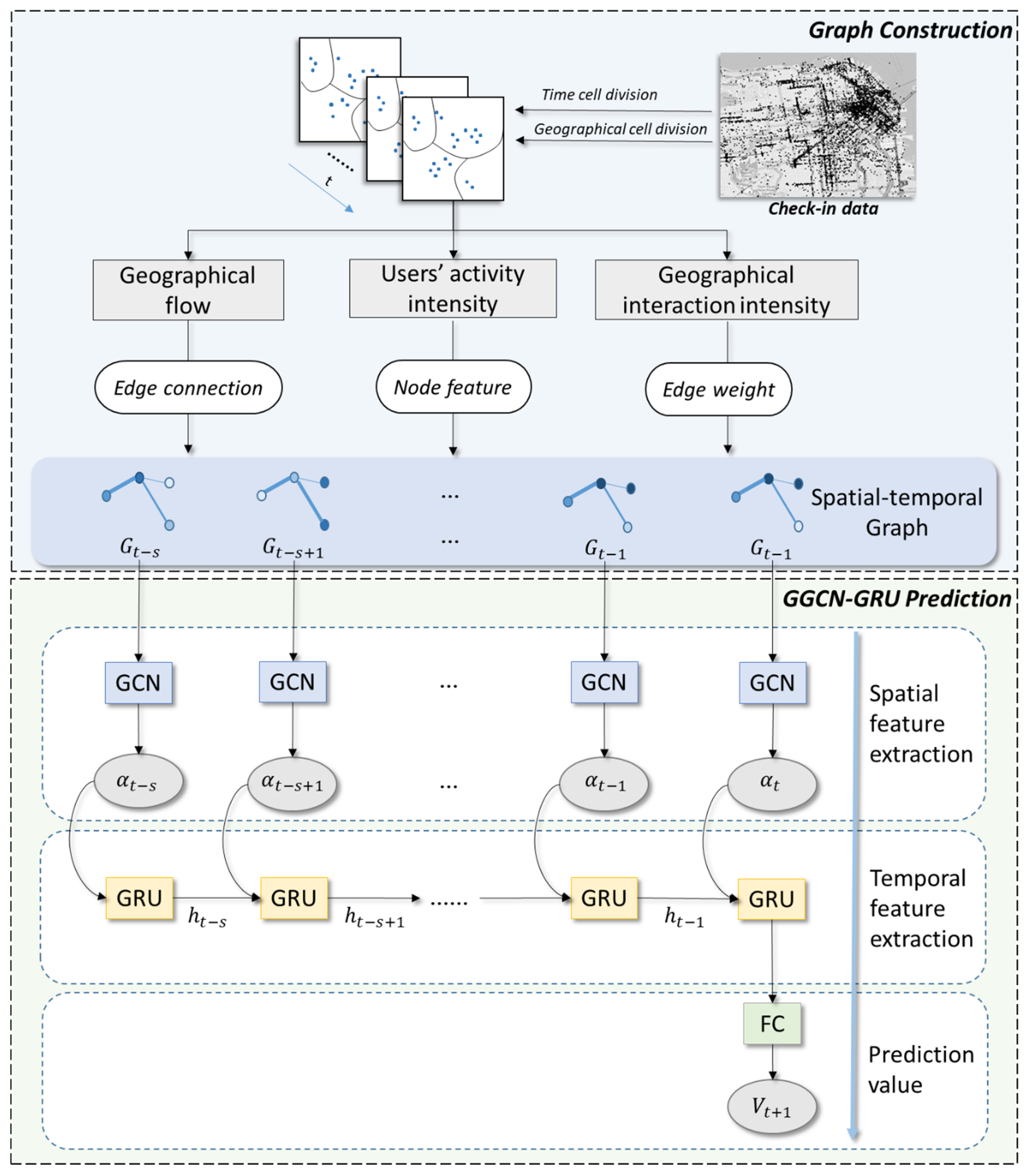


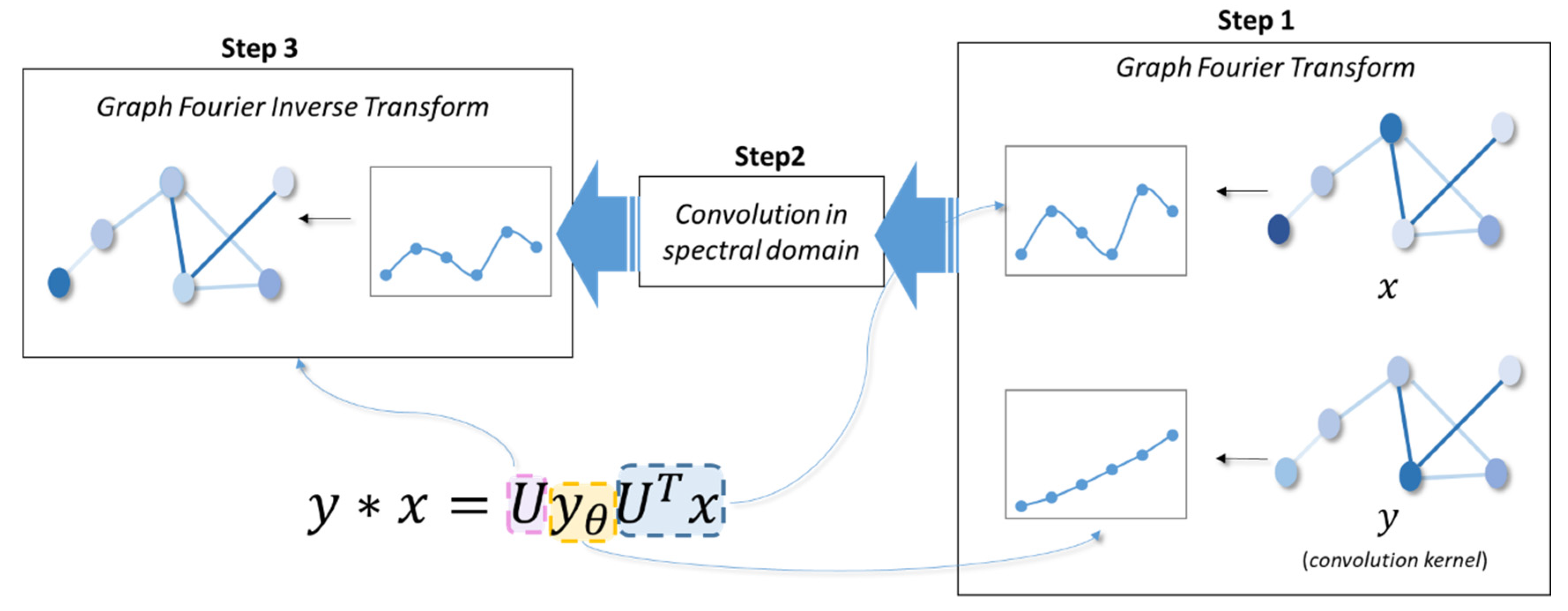



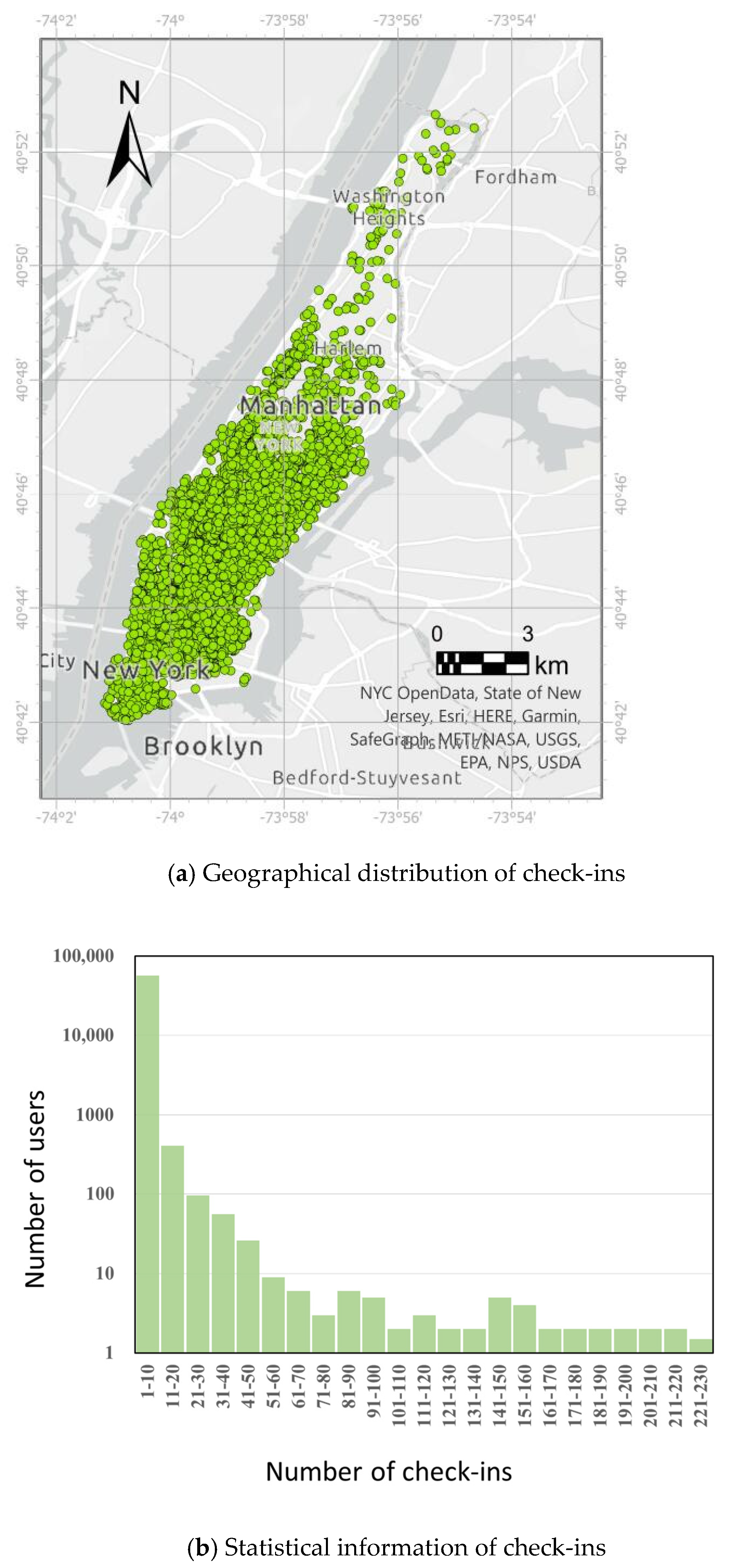


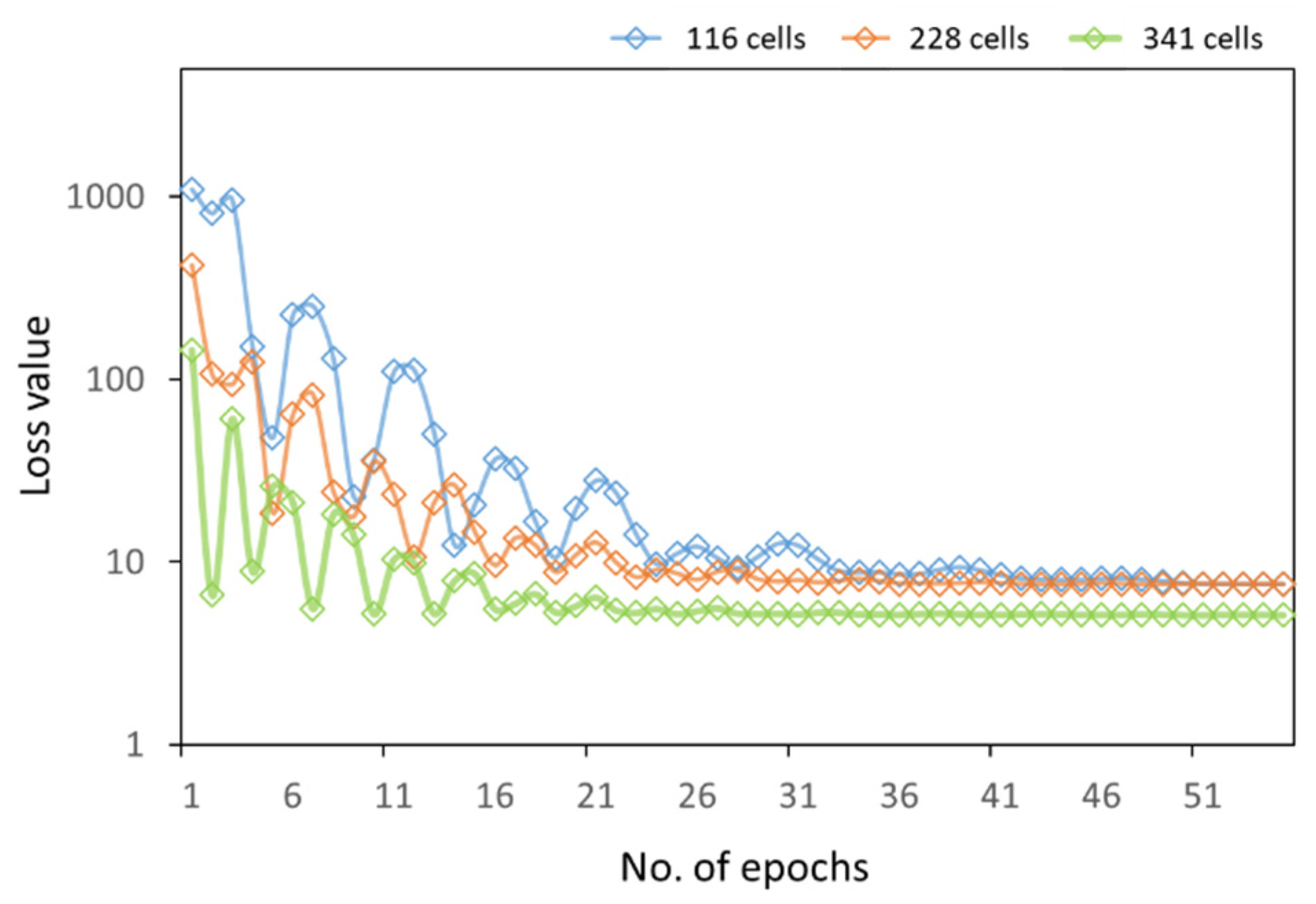
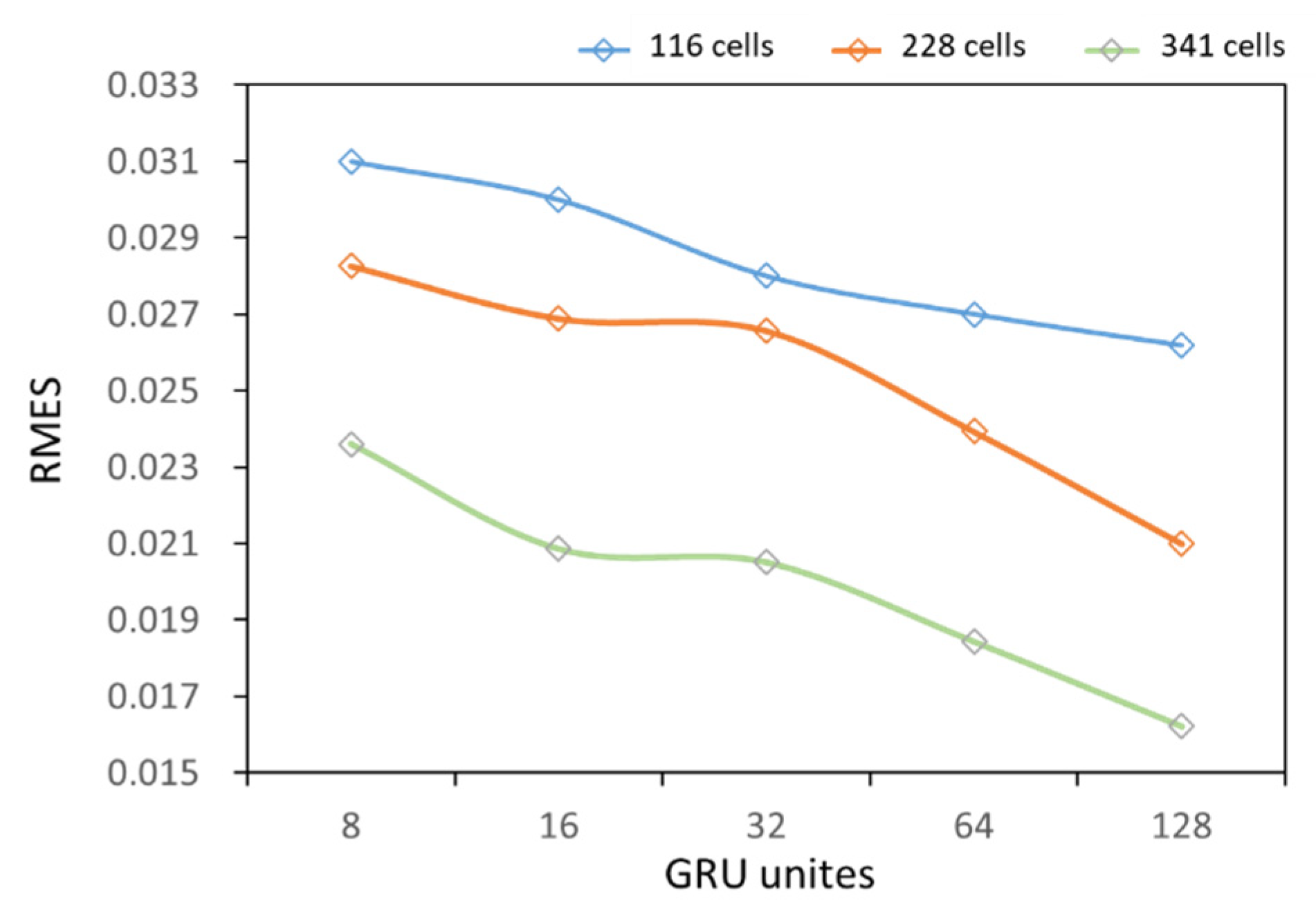
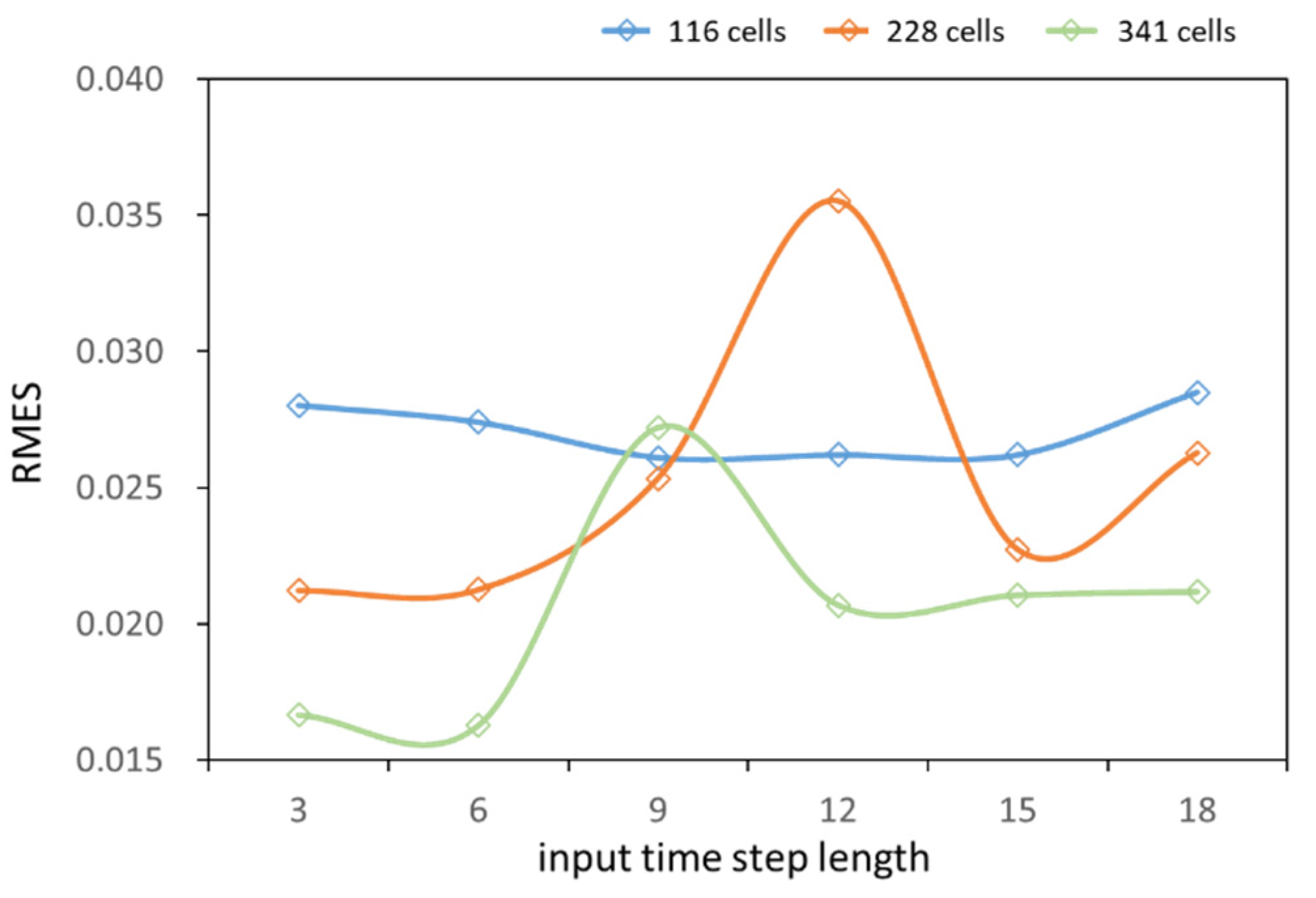


| Attributes | Samples |
|---|---|
| USER_ID | 13,299 |
| LATITUDE | 40.782 |
| LONGITUDE | −73.958 |
| DATE | 625 |
| TIME | 15:30 |
| POI_TYPE | Museum |
| POI_TYPENU | 12,348 |
| CITY | New York |
| Geographic Cells | Graph Type | Connected Nodes | Edges | RMSE | MAE | R2 |
|---|---|---|---|---|---|---|
| 116 | DBT(d ≤ 500 m) | 77 | 171 | 0.037 | 0.022 | * |
| DBT(d ≤ 1000 m) | 112 | 685 | 0.029 | 0.016 | 0.518 | |
| DBT(d ≤ 2000 m) | 116 | 1779 | 0.028 | 0.015 | 0.579 | |
| MST | 116 | 115 | 0.036 | 0.022 | * | |
| GIF | 116 | 2704 | 0.026 | 0.014 | 0.695 | |
| 228 | DBT(d ≤ 500 m) | 204 | 817 | 0.032 | 0.023 | * |
| DBT(d ≤ 1000 m) | 223 | 3119 | 0.029 | 0.019 | * | |
| DBT(d ≤ 2000 m) | 227 | 9062 | 0.032 | 0.021 | * | |
| MST | 228 | 227 | 0.025 | 0.014 | * | |
| GIF | 228 | 5212 | 0.021 | 0.011 | 0.733 | |
| 341 | DBT(d ≤ 500 m) | 315 | 1936 | 0.029 | 0.019 | * |
| DBT(d ≤ 1000 m) | 337 | 7056 | 0.020 | 0.009 | * | |
| DBT(d ≤ 2000 m) | 340 | 20,080 | 0.030 | 0.010 | * | |
| MST | 341 | 340 | 0.021 | 0.011 | * | |
| GIF | 341 | 6981 | 0.016 | 0.008 | 0.793 |
| Time Interval = 6 h | Time Interval = 12 h | |||
|---|---|---|---|---|
| Units | RMSE | MAE | RMSE | MAE |
| 116 | 0.026 | 0.014 | 0.045 | 0.027 |
| 228 | 0.021 | 0.011 | 0.024 | 0.016 |
| 341 | 0.016 | 0.008 | 0.021 | 0.012 |
| 116 Cells | 228 Cells | 341 Cells | ||||
|---|---|---|---|---|---|---|
| Model | RMSE | MAE | RMSE | MAE | RMSE | MAE |
| HA | 1.340 | 0.697 | 0.844 | 0.411 | 0.677 | 0.310 |
| ARIMA | 1.331 | 0.554 | 0.820 | 0.406 | 0.674 | 0.165 |
| SVR | 1.317 | 0.528 | 0.817 | 0.326 | 0.657 | 0.266 |
| GRU | 0.041 | 0.024 | 0.037 | 0.022 | 0.035 | 0.022 |
| T-GCN | 0.031 | 0.019 | 0.027 | 0.019 | 0.018 | 0.011 |
| GGCN-GRU | 0.026 | 0.014 | 0.021 | 0.011 | 0.016 | 0.008 |
Publisher’s Note: MDPI stays neutral with regard to jurisdictional claims in published maps and institutional affiliations. |
© 2021 by the authors. Licensee MDPI, Basel, Switzerland. This article is an open access article distributed under the terms and conditions of the Creative Commons Attribution (CC BY) license (https://creativecommons.org/licenses/by/4.0/).
Share and Cite
Li, J.; Guo, W.; Liu, H.; Chen, X.; Yu, A.; Li, J. Predicting User Activity Intensity Using Geographic Interactions Based on Social Media Check-In Data. ISPRS Int. J. Geo-Inf. 2021, 10, 555. https://doi.org/10.3390/ijgi10080555
Li J, Guo W, Liu H, Chen X, Yu A, Li J. Predicting User Activity Intensity Using Geographic Interactions Based on Social Media Check-In Data. ISPRS International Journal of Geo-Information. 2021; 10(8):555. https://doi.org/10.3390/ijgi10080555
Chicago/Turabian StyleLi, Jing, Wenyue Guo, Haiyan Liu, Xin Chen, Anzhu Yu, and Jia Li. 2021. "Predicting User Activity Intensity Using Geographic Interactions Based on Social Media Check-In Data" ISPRS International Journal of Geo-Information 10, no. 8: 555. https://doi.org/10.3390/ijgi10080555
APA StyleLi, J., Guo, W., Liu, H., Chen, X., Yu, A., & Li, J. (2021). Predicting User Activity Intensity Using Geographic Interactions Based on Social Media Check-In Data. ISPRS International Journal of Geo-Information, 10(8), 555. https://doi.org/10.3390/ijgi10080555






